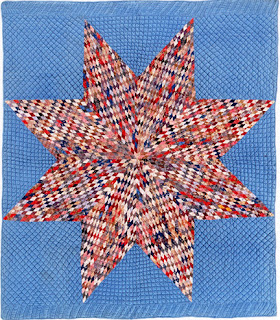Quilt about 1880-1930
A few years ago I curated a show on quilts and modernism, which got me thinking about the effects of fine art's modern aesthetic on quiltmaking. One of the first things I noticed was that the taste for simple, plain colors we see in the modern movement after 1880 or so is reflected in a taste for simple quilts we might call Lone Stars, a single large star with no patchwork in the empty spaces.
Quilt about 1930-1960
This one may be silk, the blue background is so light-reflective.
Some of these large stars are masterpieces
of modernism
but there is no way to determine if a taste for spareness in the fine arts
affected quiltmakers. There isn't any way to show a cause and effect.
The pattern itself goes back to the early 19th century.
Here's an early example framed in chintz from the collection
of the Winterthur Museum. The pattern wasn't published
until the turn of the 20th century.
It's #4005 in BlockBase. I indexed several names
for it, with the most common name being Lone Star from
the Ladies Art Company, Carlie Sexton and Ruby McKim's
pattern catalogs in the early 20th century.
The look evolved over the 19th century.
Quiltmakers working before 1880 or so
often favored pattern on pattern.
Here's a perfect clash of patchwork pattern and fabric pattern
in a star pieced into a background of Mexican War victory print
about 1850.
The quilt is from the Dillow collection at the International Quilt Study Center and Museum.
A glimpse of a splashy mid-19th-century example
at an antique show.
This star from the collection of the Charleston Museum
combines two looks: the bold star
with the chintz-era's love of a busy border.
Pennsylvania Mennonite quilt dated 1881
from the Flack Collection
In the 1880s a new look appears.
Dated September 15, 1887 by CCR,
She just couldn't resist putting those diamonds in the corners.
Rather than modernism affecting quilts it's probably more a case of a parallel shift ---simplicity holding a new appeal for people weary of visual clutter.
Some of the boldest examples of the late-19th/early-20th-century stars
were made in Southeastern Pennsylvania.
If you look close you'll see light streaking in the background. The problem is
that quilters were looking for contrasting solid colors in the era
of unstable solid-colored cottons. The blue-greens often faded to
khaki with any exposure to light, even folded up on a shelf.
You can see the fold marks where light hit the edges.
Washing was hard on the new solids too.
Here's one dated 1879 that probably had a lot more impact before it faded.
Top dated 1926
Several threads came together in the late 1920s to make a simple Lone Star one of the more popular patterns of the new thirties-style:
Quilt date-inscribed 1934
1) More reliable dyes in new shades.
McKim promoted the pattern and sold kits in the '30s.
Ready Cut Lone Star $4.50
2) Artists like Ruby Short McKim who knew a lot about modernism. They saw in these compositions a new approach to old-fashioned patchwork.
3) Several pattern companies sold patterns and/or kits. Here Hubert Ver Mehren advertised it as a Star of Bethlehem.
Like the Broken Star pattern, the Lone Star trend was
influenced by die-cut kits.
See Ann Champion's blog post on an Aunt Martha kit.
And read Jinny Beyer's thoughts on color and fragmenting




























Lovely. I made one of these quilts and although there are plenty of patterns, I had to draft my very own. thanks for sharing.
ReplyDeleteThis pattern was also popular as a native American give away. I have made them to celebrate weddings and graduations. In fact, I grew up sleeping under one made by me great grandmother.
ReplyDeleteLove this post. MAde me remember that one of my first quilts was an orange, yellow and brown Lone Star made from an Aunt Martha kit. I think I still have a kit of a Broken Star...yikes that was a long time ago. Thanks for the post and the memories.
ReplyDelete